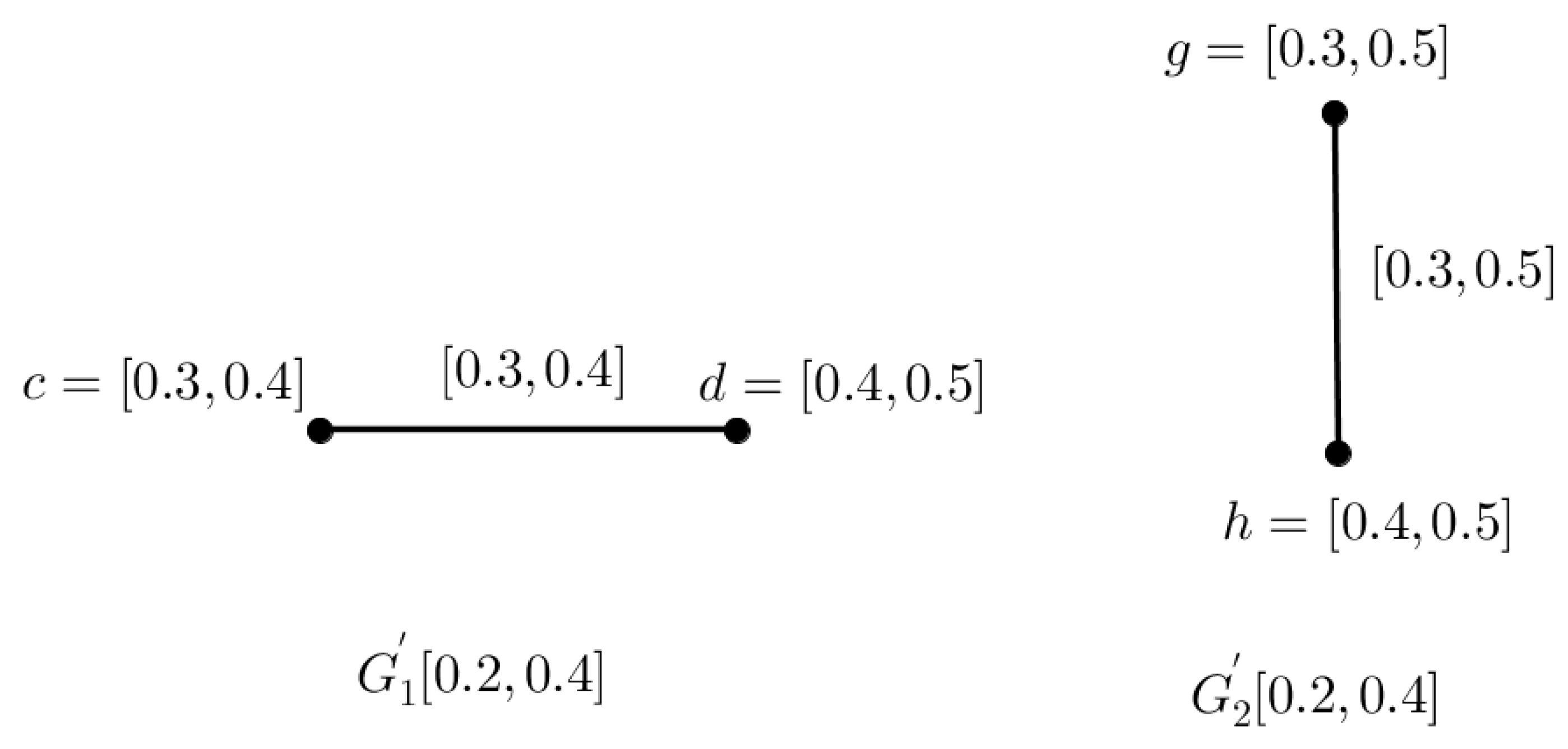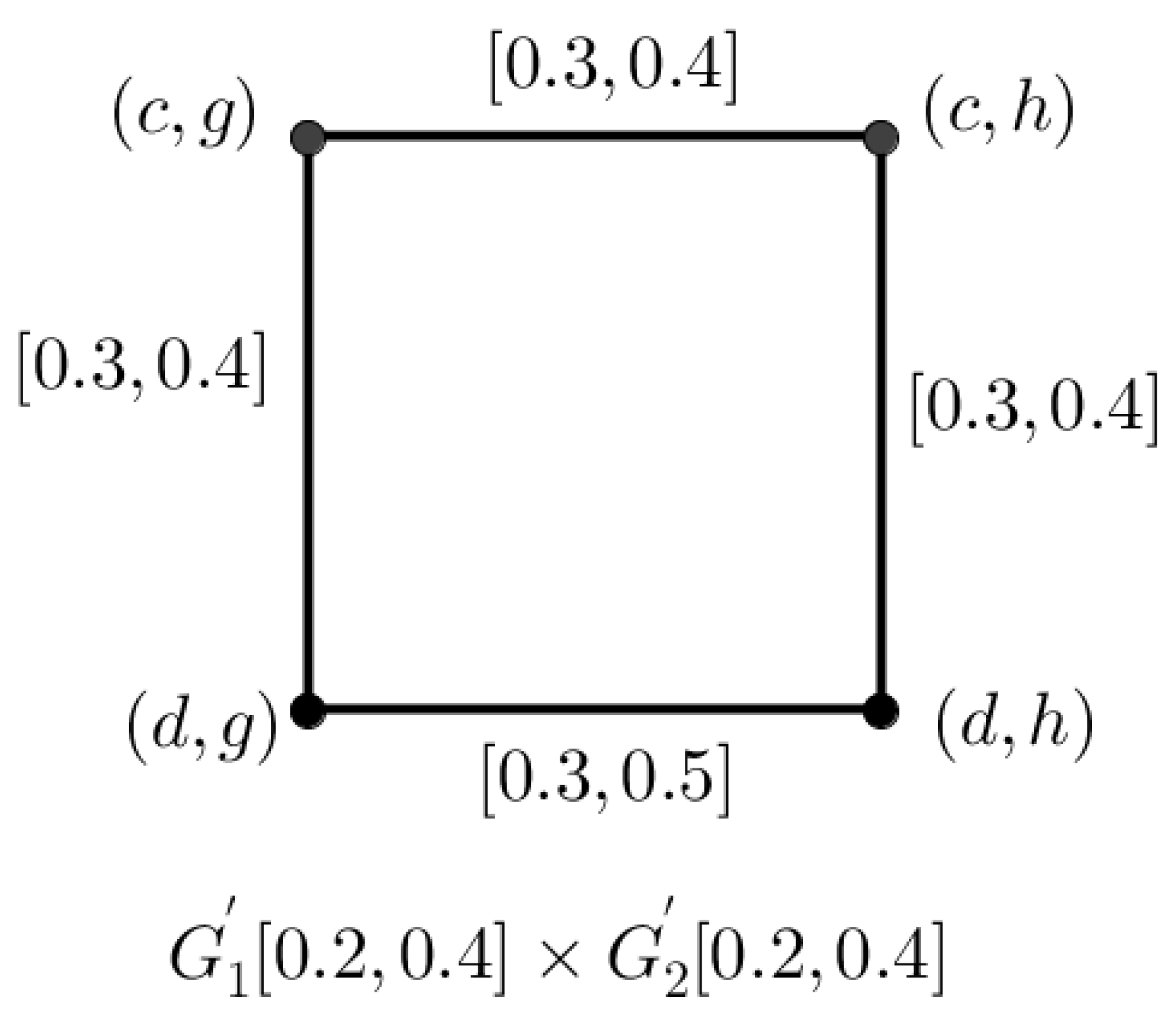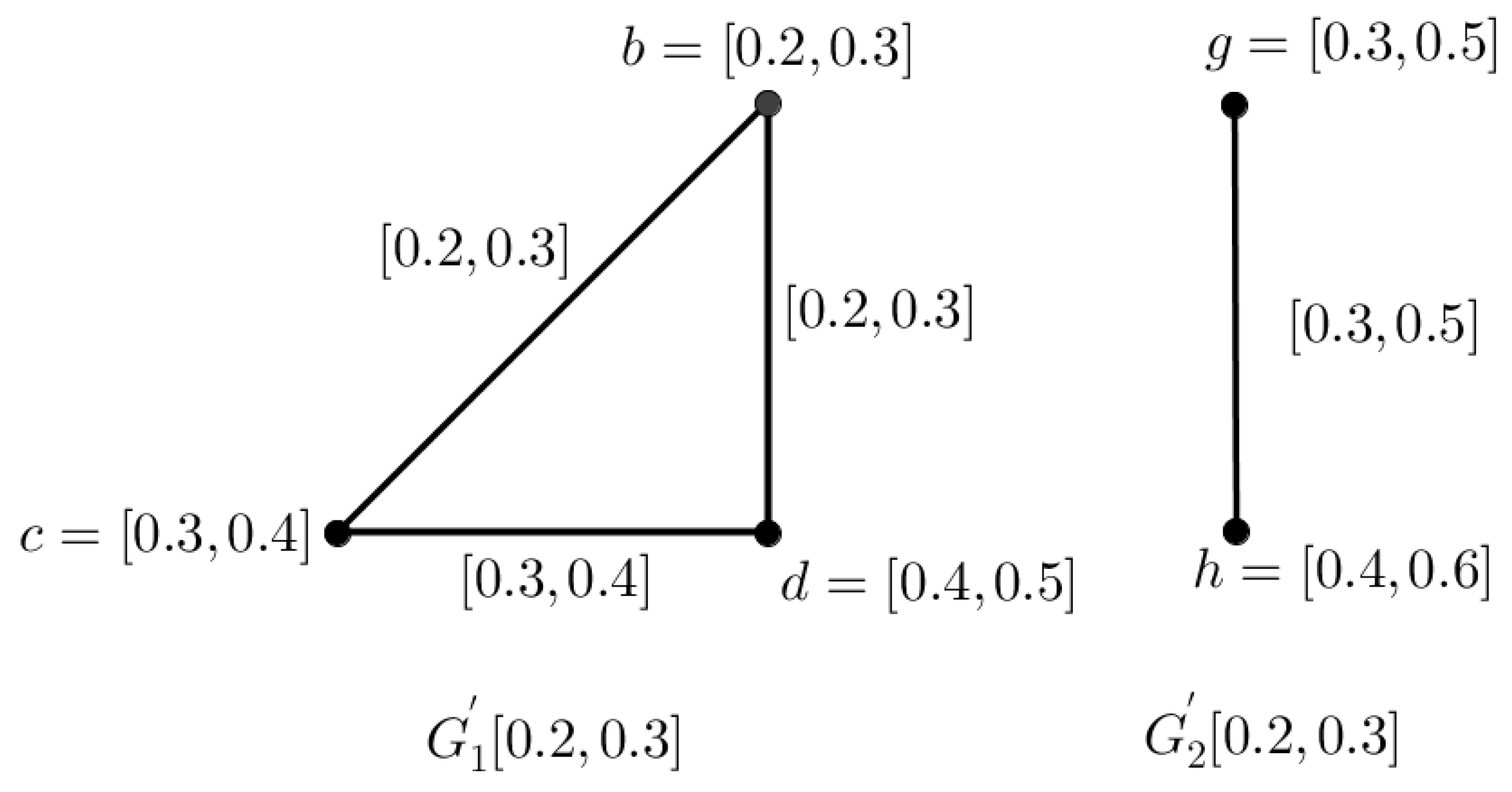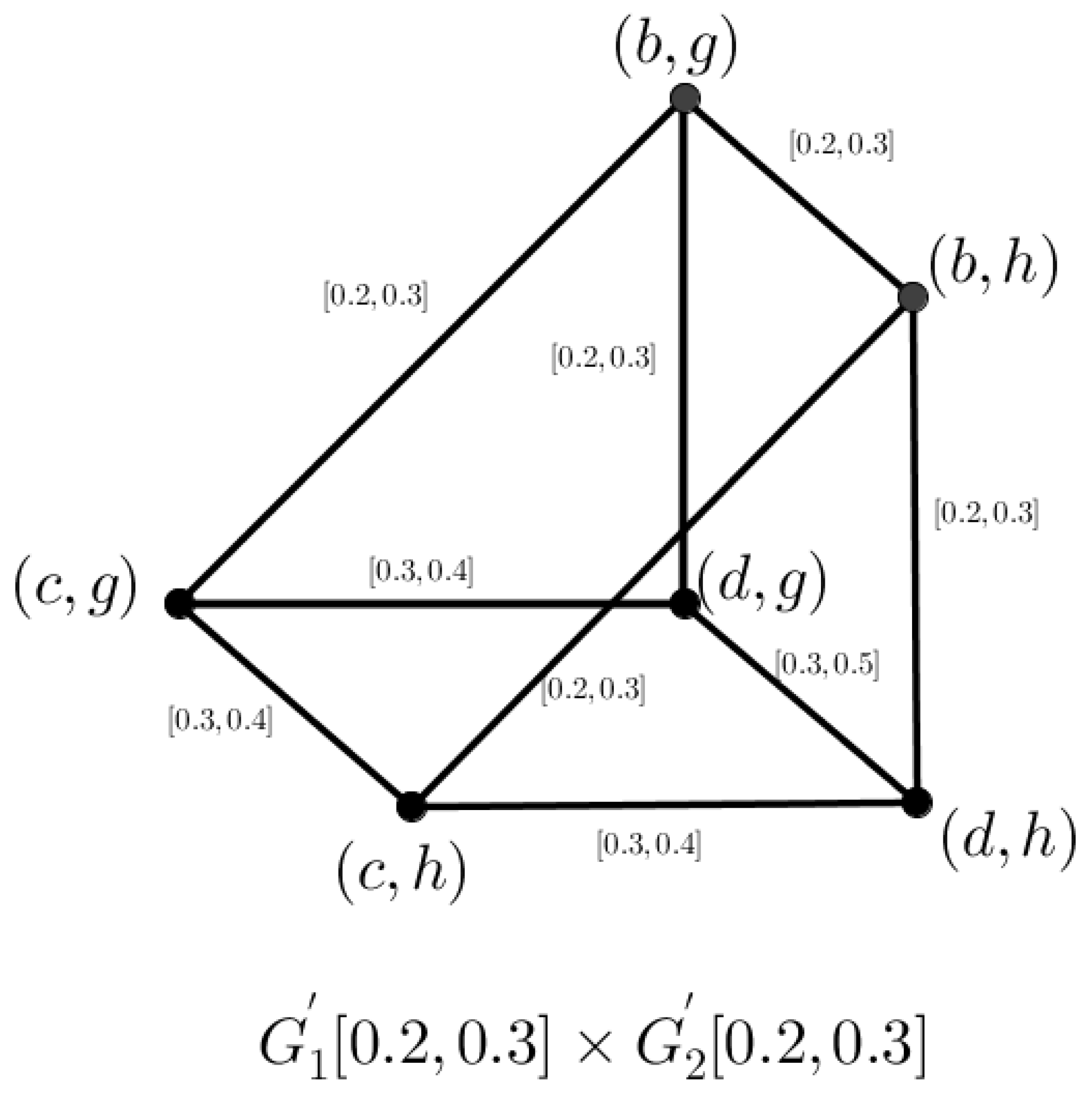3. Level Graphs of the Interval-Valued Fuzzy Graphs
In this section, we introduce a new concept of level graph on IVFGs.
Definition 5. For all , -level set of an IVFS R on X is defined to be .
Theorem 1. Suppose that X is a nonempty set, and and are IVFGs on X and E, respectively. Then, is an IVFG if and only if , named the -level graph of , is a graph for every
Proof. Let
be an IVFG. For each
, if
, then,
. Since
is an IVFG,
and so
,
,
,
, that is,
.
Therefore, is a graph for every
Conversely, suppose
is a graph for all
. For each
, we consider
and
. Then,
. Since
is a graph; thus, we have
. Hence,
,
,
, and
. Therefore,
that is, is an IVFG. □
Theorem 2. Suppose and are the IVFGs of and , respectively. Then, the pair of an IVFG on and is the CP of and if and only if for every the -level graph is the CP of and .
Proof. Suppose that
is the CP of the IVFGs
and
. For each
, if
, then
Therefore, and ; that is,
Therefore,
. If
, then
and
. Here, we have
Because
is the CP of
and
,
and
, so we have
Thus,
Now, we prove , such that E is the edge set of the CP for every .
Suppose
. Therefore,
Since is the CP of and , it satisfies one of the below conditions:
- (i)
and ,
- (ii)
and .
In the first condition (i), we have:
and so , , ,
It follows that and ; that is, .
Similarly, for condition (ii), we conclude Thus, . For each , , , ,
Because
is the CP of
and
, we have:
Therefore, Similarly, for each , we have Thus, , and so
Conversely, suppose the -level graph is the CP of and , for all
Suppose
and
, for
Then,
and
By the hypothesis,
. Hence,
Consider
and
. Then, we have
. Since
is the CP of
and
, then
and
Hence,
Therefore,
for all
That is,
For each
and
, suppose
Then, , , , and , i.e., , , and
Since is the CP of and , and also is the CP of and we have , , and
which implies ,
for all
and
Also, similarly, we obtain
for all and □
Example 1. Suppose and are two IVFGs of the graphs and , respectively, so that , , , and , as is shown in Figure 1. We obtained the CP of the IVFGs and , which are shown in Figure 2. Assume . Then, , , and , as is shown in Figure 3. We obtain the CP of the IVFGs and . The CP of the IVFGs and is shown in Figure 4. Here, we investigated the properties of the CP IVFGs and from their -level graphs of and .
We concluded that the pair is the CP of and if and only if the -level graph is the CP of the two graphs and .
Also, we consider . Then, , , , and , is shown in Figure 5. We obtain the CP of the IVFGs and . The CP of the IVFGs and is shown in Figure 6. In this example, we investigated the properties of the CP IVFGs and from their -level graphs of and .
We concluded that the pair is the CP of and if and only if the -level graph is the CP of two graphs and .
Corollary 1. Let and be IVFGs. Then, the CP is an IVFG.
Theorem 3. Suppose and are two IVFGs of and , respectively. Then, the pair of the IVFGs on is the CO of and if and only if for every , the -level graph is the CO of and .
Proof. Suppose that is the CO of the IVFGs and . By Theorem 2, we have . We prove , where E is the edge set of the CO , for all .
Suppose . Then, and
Since is the CO , one of the below conditions holds:
- (i)
and
- (ii)
and
- (iii)
and
For conditions (i) and (ii) in the proof of Theorem 2, we obtain
. For case (iii), we have
It follows that
and
; that is,
Thus,
For each
,
Since
is the CO
, we have
Thus,
. Similarly, for each
, we have
For each
,
.
Since
is the CO
, we have:
Hence, . Therefore, and so
Conversely, let , be the CO of , and . By Theorem 2, we have
- (i)
for all (e1, e2) ∈ X1 × X2.
- (ii)
for all e ∈ X1 and e2f2 ∈ E2.
- (iii)
for all k ∈ X2 and e1f1 ∈ E1.
for all , and □
Corollary 2. Let and be IVFGs. Then, the CO is an IVFG.
Theorem 4. Assume and are IVFGs of and , respectively, so that Then, is the union of and if and only if for every , the level graph is the union of and .
Proof. Suppose that is the union of the IVFGs and . We show that for every
Assume that , then or . If , then and , which implies If , we have Therefore, , and so
Let then , or and In the first situation, and , which implies . In the second condition, and , hence .
Consequently, . We prove that for all . Assume that , then or .
For , we have and Therefore, . Also, if , then Thus,
If , then or
In the first situation, and , which implies .
In the second condition, there is also . Thus, .
Conversely, suppose for all , is the union of and . Let and , for .
Then, and . By the hypothesis, and
It follows, . Hence,
Similarly, for every , we obtain
Also, we obtain:
(i)
(ii) □
Corollary 3. Let and be IVFGs of and , respectively, and , then is an IVFG.
Theorem 5. Suppose and are IVFGs of and , respectively, and Then, the pair of the IVFGd on is the join of and if and only if for every , is the join of and
Proof. Suppose that is the join of the IVFGs and . We show that and for all , where is the set of all edges joining the nodes and
According to the proof of Theorem 4,
. If
, then
Hence,
Therefore, . It follows, .
For each
, if
, then
. If
and
, then
Therefore, , , and
Thus,
Conversely, suppose is the join of and for
We have
- (i)
- (ii)
Also, we obtain
- (iii)
- (iv)
Suppose , and consider , , ,
Then, , and
It follows that
,
and
So,
Therefore,
□
4. Application of Interval-Valued Fuzzy Graph to Find the Most Effective Person in a Hospital Information System
The growth of the communication, telecommunication, and informatics industries is facing a new revolution every day. The information and communication technology revolution has had a profound effect on all economic, social, political, and security sectors of the country. One of the most important areas of information technology applications is in the field of health and treatment. A hospital information system is the first and most basic system for providing health care. Hospital information systems are computer systems designed to easily manage medical and hospital information and to improve the quality of health care. Research has shown that the use of hospital information systems has improved the quality of health services and increased customer satisfaction. Some of the problems of health care systems are as follows: the dispersion of patients’ information and lack of access to their records, poor cooperation between physicians and health care workers, and poor access to required medical information. These problems can be solved through the development of information technology, especially hospital (health) information systems. Hospital information systems are designed to automate the affairs of hospitals, such as reporting test results, entering doctor’s instructions, prescribing medication, controlling pharmacy inventory, central warehouses, feeding units, etc. In the hospital information system, an electronic file is created for each patient that covers all hospital activities (including treatment, diagnosis, finance, etc.) from admission to discharge. In this system, all medical procedures, medication orders, and diagnostic services are sent through the system to clinics and paraclinics and even administrative centers, such as accounting, pharmacies, warehouses, and other units, and their answers are received. Therefore, the start and end times of all actions in the system are clear and traceable. Hence, a hospital information system is an information system in which information is stored in a comprehensive database and is available to consumers in special forms at the time and place of need. Therefore, considering the importance of the hospital information system and its role in improving medical and health services, we intend to specify the most effective employee in the field of technology and information of a hospital in terms of registering information about patients, medicines, finances, laboratories, etc. Suppose the vertices of the IVFG are an information register building and the edges of this graph are the degree of interaction in between. The set of staff is
A = {Moradi, Kamali, Ahmadi, Yegane, Bahmani, Nazari}
- (a)
Moradi and Bahmani have been co-workers for 16 years.
- (b)
Yegane is very accurate in calculating and recording information about the hospital’s finances, and all employees are satisfied with him.
- (c)
In recording information about nurses, it is very important to record their expertise, work experience, and the duration of each activity during a day with great care to have the most active nurses serve patients. Kamali is the best choice to undertake this accountability process.
- (d)
Nazari and Ahmadi have a long history of conflict.
- (e)
According to Ahmadi’s experiences recognizing drugs and their effectiveness, he is the best option for recording information about drugs.
According to the above values, we consider an IVFG. The vertices show each of the department staff members. The edges indicate the level of friendship and fondness between staff. For the weight of the vertices, the lower bound and the upper bound mean the level of staff capability. The lower bound and the upper bound for the weight of the edges mean the amount of friendship and conflict, respectively. The name of the staff and level of staff capability are indicated in
Table 1 and
Table 2. The adjacency matrix corresponding to
Figure 7 is indicated in
Table 3.
Figure 7 shows that Ahmadi has
of the necessary ability to register drug information in the system, but unfortunately, he does not have the necessary
authority to do so. The directional edge Yegane–Nazari indicates that there is only
comradeship among these two staff members, and unfortunately they have
conflict. Clearly, Kamali has dominion over both Moradi and Yegane, with his dominance over both at
. It is clear that Kamali is the most influential staff member of the hospital information system because he inspects both the laboratory information officer and the pecuniary information officer and has
of the authority in the hospital.
As we saw in the above example, fuzzy influence graphs play a significant role in determining worthy and effective people in an organization and social institutions, and they are used in the fields of medical and psychological sciences to diagnose diseases. Interval-valued fuzzy influence graphs are useful tools for chemical engineers to model various relationships in a process. These graphs are used to systematically map an entire chain of processes and controllers to describe the effect. The interval-valued fuzzy influence graph theory is growing as a dominant field of research in mathematics because of its application to a variety of problems, including clustering, data mining, decision-making, communication, etc. It has major contribution potential in modeling, preserving, and performing different types of physical problems in networking and trafficking. Several interval-valued fuzzy influence graph parameters are real indicators of network performance and efficiency. They are very useful to handle networks with extraneous support and flows. Especially, the modeling of the ramping system of highways can be performed using interval-valued fuzzy influence graphs in order to control the unpredicted flow between cities and highways.














